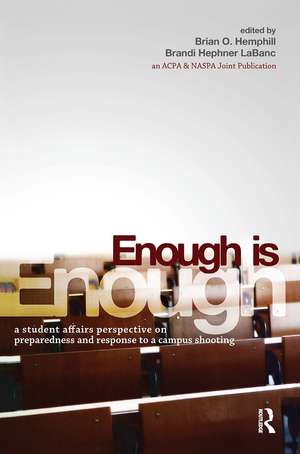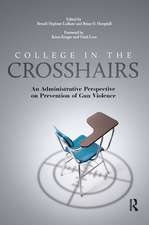Enough Is Enough: A Student Affairs Perspective on Preparedness and Response to a Campus Shooting
Editat de Brian O. Hemphill, Brandi Hephner LaBancen Limba Engleză Paperback – 8 mar 2010
| Toate formatele și edițiile | Preț | Express |
|---|---|---|
| Paperback (1) | 302.78 lei 6-8 săpt. | |
| Taylor & Francis – 8 mar 2010 | 302.78 lei 6-8 săpt. | |
| Hardback (1) | 998.21 lei 6-8 săpt. | |
| Taylor & Francis – 8 mar 2010 | 998.21 lei 6-8 săpt. |
Preț: 302.78 lei
Nou
Puncte Express: 454
Preț estimativ în valută:
57.94€ • 60.57$ • 48.96£
57.94€ • 60.57$ • 48.96£
Carte tipărită la comandă
Livrare economică 06-20 martie
Preluare comenzi: 021 569.72.76
Specificații
ISBN-13: 9781579224431
ISBN-10: 1579224431
Pagini: 216
Dimensiuni: 152 x 229 x 12 mm
Greutate: 0.29 kg
Ediția:1
Editura: Taylor & Francis
Colecția Routledge
Locul publicării:Oxford, United Kingdom
ISBN-10: 1579224431
Pagini: 216
Dimensiuni: 152 x 229 x 12 mm
Greutate: 0.29 kg
Ediția:1
Editura: Taylor & Francis
Colecția Routledge
Locul publicării:Oxford, United Kingdom
Public țintă
Postgraduate and Professional Practice & DevelopmentCuprins
Dedication Acknowledgments Foreword 1. Violence In The Shadow Of The Ivory Tower. Murder At The University The University as a Safe Haven; Single and Double Murders. Clery and Beyond Clery; Gender Factors; One- and Two-Person Killings on Campus That Had the Potential to Turn Into Mass-Casualty Situations; Multiple Murders; The Bell Tower Shooting at the University of Texas; The Dual Shootings at Virginia Tech; The Cole Hall Mass Shooting at Northern Illinois University; Some Comparative Aspects of the Three Mass-Murder-Status Killers; The Nexus Between Suicide and Homicide; Heterogeneity in Murder Cases Involving University Students; Rara Avis or Frequent Bird of Prey; Expressed and Actual Violence; The Scale of Violence; References 2. The Emotional Health And Violence Connection. Prevention, Intervention, and Resiliency College Mental Health. A Growing Concern; Mental Health and Violence; Lessons from Virginia Tech. The Importance of Connection and Support; Emotional Health Safety Net. The Prescription for Prevention and Resiliency; The Emotional Health and Violence Connection. Taking Action on Your Campus; Conclusion; References 3. Managing the Whirlwind. Planning For and Responding to a Campus in Crisis Introduction; Planning for and Responding to Crisis; Campus Emergency Operations Plan; Student Affairs Crisis Response Teams; Victim Liaisons; Coordination of Resources; Federal, State, and Local Resources; Campus- and Community-Based Resources; Additional Considerations; Threat Assessment Teams; Communication During Crises; Emergency Notification; Campus Responders; Media Relations; Crisis Hotlines; Information Management During Crises; Conclusion; References 4. Counseling During a Campus-Wide Crisis Introduction; Immediate Response; Population Exposure Model; Immediate Psychological Responses to Trauma; On-Going Response; Mental Health Agencies; Day 2 Response; Campus Gatherings; Preparing Faculty and Staff to Return to Class; Classroom Outreach Program; Logistics; Psychological First Aid; Psycho-education; Long-Term Implications and Other Considerations; Psychological Effects of Trauma; Interagency Agreements; Ethical and Legal Considerations; Self Care; Conclusion; References 5. Essential Student Affairs Services In A Campus Crisis Introduction; Defining and Developing Policy for Essential Services; Housing and Dining; Student Activities; International Student Services; Conclusion; References 6. Healing Your Community Introduction; A University Provides Opportunities to Heal; A Community Expresses Itself; Local Community Support; Issues of Sensitivity; Fundraising as a Support Mechanism; From Grieving to Healing; Religion Debate; The Message; Long-Term Community Healing Initiative; Offices for On-Going Support; Conclusion; References; 7. The Provost’s Perspective. Campus-Wide Needs And Responses Introduction; President and External Relations; Students and Their Families; Other Academic Leaders, Faculty, and Staff; Unique Organizational Qualities in Higher Education; that Shape and Influence Emergency Planning and Response; Decision-Making in Real Time During Crises; Academic Impact and Accommodations; Academic Calendar; Student Issues; Faculty Issues; Facilities Issues; The Provost and Student Affairs in the Event of a Shooting; Formative Feed-back, Reflections, and Unexpected Experiences; Emergency Operations Plans (EOP. and Emergency Operations Center (EOC); Communication; Volunteer Assistance; Financial and Legal Issues; Conclusion 8. Too Close To Home. The Reality Of Campus Shootings Introduction; Reaction to the Virginia Tech Shootings; Shootings at Northern Illinois University; Graffiti Incidents Follow NIU Shootings; Conclusion; References 9. Incorporating Words Of Wisdom Into The Crisis Management Process Introduction; Prevention and Mitigation; Words of Wisdom #1. Timely and Extensive Early Warning Systems Save Lives; Words of Wisdom #2. Information Sharing, Students’ Threat Assessment, and Early Behavioral Intervention Are Proactive Ways of Mitigating Student Violence; Crisis Planning and Preparation; Words of Wisdom #3. Create a Comprehensive Student Affairs Crisis Response Management Plan; Words of Wisdom #4. Intentional Selection of a Student Affairs Crisis Response Team Leader Is Critical; Words of Wisdom #5. “Practice Makes Perfect” Is Especially True for Dealing with Campus Crisis Situations; Words of Wisdom #6. Pre-Established Communication Messages Enhance Efficiency in Crisis Response; Words of Wisdom #7. Public Relations Plans and Message Controls Are Vital in Crisis Response; Immediate Response (First 24 Hours); Words of Wisdom #8. Response to a Campus Crisis Is Everyone’s Job.; Words of Wisdom #9. Reach Out to Those Who Have Experienced the Trenches.; Words of Wisdom #10. Develop Alternate Means of Communication.; Words of Wisdom #11. Police Officers’ EMT Training Saves Lives.; Words of Wisdom #12. Open Communication to the Students, Families, and Media Demonstrates Care; Response (First Seven Days); Words of Wisdom #13. Develop an Inter-Agency Agreement with Local and/or Regional Mental Health Providers; Words of Wisdom #14. Know and Utilize Campus Resources; Words of Wisdom #15. Liaisons Help Humanize Your Campus’ Bureaucracy During the Crisis Response; Campus Healing; Words of Wisdom #16. Self-Care During a Crisis Is More Difficult but More Vital; Words of Wisdom #17. Adding More Guns to College Campuses Is Not the Answer; Words of Wisdom #18. Enough is Enough. About the Contributors References
Notă biografică
Brian O. Hemphill joined West Virginia State University in July 2012 as the University’s 10th president. His emphasis since arriving on campus is threefold: to establish a commitment to excellence, to create a culture of accountability and to be student-centered in every process at State. President Hemphill has a strong background in student advocacy, advancing diversity and equity and establishing a solid commitment to shared governance on campus. He has contributed to numerous journal articles and professional presentations in the areas of leadership, crisis management, ethics, and diversity. Most recently, Dr. Hemphill was the editor of the monograph, Enough is Enough: A Student Affairs Perspective on Preparedness and Response to a Campus Shooting. He has fulfilled various leadership roles within the Student Affairs Administrators in Higher Education (NASPA), which named him a Pillar of the Profession in 2009. President Hemphill came to WVSU following an eight-year tenure as Vice President for Student Affairs & Enrollment Management and Associate Professor, at Northern Illinois University. Prior to joining NIU, he served as an associate vice chancellor and dean of students at the University of Arkansas-Fayetteville, associate dean of students at University of North Carolina-Wilmington, assistant dean of students at Cornell College, and coordinator of minority recruitment and retention at Iowa State University. President Hemphill earned a Ph.D. in Higher Education Administration from the University of Iowa, a Master of Science degree in Journalism and Mass Communication from Iowa State University of Science and Technology, and a Bachelor of Arts degree in Organizational Communication from St. Augustine’s College. Brandi Hephner LaBanc was appointed Vice Chancellor for Student Affairs in July 2012 at Ole Miss, providing leadership and direction for all of the departments encompassed by the Division of Student Affairs. She also serves as a faculty member in
Recenzii
"The blend of concrete data and analysis; detailed descriptions of policies and processes from prevention through crisis management to long-term healing; and the genuine stories of personal impact make this book unique in the postcrisis literature. The fact that it is also an easy read makes it a must read for us all."
Journal of College Student Development
"I consider this book a must read for college administrators. To-do lists and checklists for building or improving campuses’ readiness and resilience in dealing with crises can be easily constructed with the substantial information and suggestions provided through the book....In sum, Enough is Enough is a practical guide for campus administrator to prepare their campus for the worse case scenarios of campus violence."
NACADA Journal (National Academic Advising Association)
“Enough is Enough is an important work for college and university leaders struggling with the complex issues of violence prevention, emergency preparedness, critical incident response and community recovery and healing. Although written from a student affairs perspective, it contains powerful lessons for all campus administrators. Enough is Enough should be mandatory reading for everyone at the academy involved in keeping the campus community safe!”
Steven J. Healy, Managing Partner, Margolis, Healy & Associates, and Past President
International Association of Campus Law Enforcement Administrators
“Excellent addition to the higher education crisis management literature with its specific focus on campus violence. The combination of research data to inform the reader on the issues of campus violence as well as the practical tips and suggestions for preparing and responding to acts of campus violence makes this an extremely valuable tool for the profession.”
Eugene Zdziarski, Vice President for Student Affairs and Dean of Students
Roanoke College
Journal of College Student Development
"I consider this book a must read for college administrators. To-do lists and checklists for building or improving campuses’ readiness and resilience in dealing with crises can be easily constructed with the substantial information and suggestions provided through the book....In sum, Enough is Enough is a practical guide for campus administrator to prepare their campus for the worse case scenarios of campus violence."
NACADA Journal (National Academic Advising Association)
“Enough is Enough is an important work for college and university leaders struggling with the complex issues of violence prevention, emergency preparedness, critical incident response and community recovery and healing. Although written from a student affairs perspective, it contains powerful lessons for all campus administrators. Enough is Enough should be mandatory reading for everyone at the academy involved in keeping the campus community safe!”
Steven J. Healy, Managing Partner, Margolis, Healy & Associates, and Past President
International Association of Campus Law Enforcement Administrators
“Excellent addition to the higher education crisis management literature with its specific focus on campus violence. The combination of research data to inform the reader on the issues of campus violence as well as the practical tips and suggestions for preparing and responding to acts of campus violence makes this an extremely valuable tool for the profession.”
Eugene Zdziarski, Vice President for Student Affairs and Dean of Students
Roanoke College
Descriere
Are your violence prevention and mental health efforts on campus coordinated? Recent campus crises have highlighted that campus administrators will be judged by three things: What the campus was doing before the crisis, its immediate response during the crisis, and the follow-up after the crisis.














